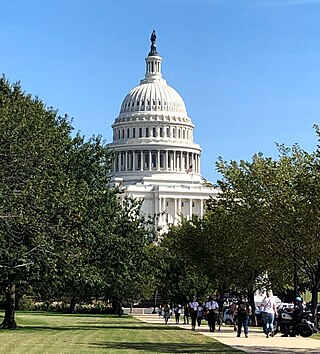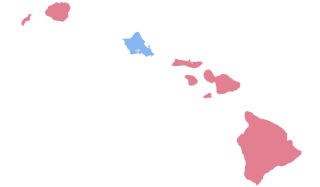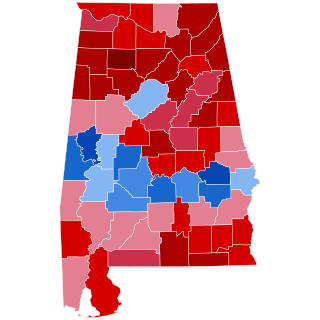
The Twelfth Amendment to the United States Constitution provides the procedure for electing the president and vice president. It replaced the procedure in Article II, Section 1, Clause 3, under which the Electoral College originally functioned. The amendment was proposed by Congress on December 9, 1803, and was ratified by the requisite three-fourths of state legislatures on June 15, 1804. The new rules took effect for the 1804 presidential election and have governed all subsequent presidential elections.

The vice president of the United States (VPOTUS) is the second-highest officer in the executive branch of the U.S. federal government, after the president of the United States, and ranks first in the presidential line of succession. The vice president is also an officer in the legislative branch, as the president of the Senate. In this capacity, the vice president is empowered to preside over the United States Senate, but may not vote except to cast a tie-breaking vote. The vice president is indirectly elected together with the president to a four-year term of office by the people of the United States through the Electoral College. Since the passage of the Twenty-fifth Amendment to the US Constitution, the vice president may also be appointed by the president to fill a vacancy, via majority confirmation by both the Senate and the House.

In the United States, the Electoral College is the group of presidential electors that is formed every four years for the sole purpose of voting for the president and vice president. The process is described in Article II of the U.S. Constitution. Each state appoints electors using legal procedures determined by its legislature, equal in number to its congressional delegation totaling 535 electors. A 1961 amendment granted the federal District of Columbia three electors. Of the current 538 electors, a simple majority of 270 or more electoral votes is required to elect the president and vice president. If no candidate achieves a majority there, a contingent election is held by the House of Representatives to elect the president and by the Senate to elect the vice president. Federal office holders, including senators and representatives, cannot be electors.

The Electoral Commission, sometimes referred to as the Hayes-Tilden or Tilden-Hayes Electoral Commission, was a temporary body created by the United States Congress on January 29, 1877, to resolve the disputed United States presidential election of 1876. Democrat Samuel J. Tilden and Republican Rutherford B. Hayes were the main contenders in the election. Tilden won 184 undisputed electoral votes, one vote shy of the 185 needed to win, to Hayes' 165, with 20 electoral votes from four states unresolved. Both Tilden and Hayes electors submitted votes from these states, and each claimed victory.

A joint session of the United States Congress is a gathering of members of the two chambers of the bicameral legislature of the federal government of the United States: the Senate and the House of Representatives. Joint sessions can be held on any special occasion, but are required to be held when the president delivers a State of the Union address, when they gather to count and certify the votes of the Electoral College as the presidential election, or when they convene on the occasion of a presidential inauguration. A joint meeting is a ceremonial or formal occasion and does not perform any legislative function, and no resolution is proposed nor vote taken.
The president-elect of the United States is the candidate who has presumptively won the United States presidential election and is awaiting inauguration to become the president. There is no explicit indication in the U.S. Constitution as to when that person actually becomes president-elect, although the Twentieth Amendment uses the term "president-elect", thus giving the term "president-elect" constitutional justification. It is assumed the Congressional certification of votes cast by the Electoral College of the United States – occurring after the third day of January following the swearing-in of the new Congress, per provisions of the Twelfth Amendment – unambiguously confirms the successful candidate as the official "president-elect" under the U.S. Constitution. As an unofficial term, president-elect has been used by the media since at least the latter half of the 19th century, and was in use by politicians since at least the 1790s. Politicians and the media have applied the term to the projected winner, even on election night, and very few who turned out to have lost have been referred to as such.

The 117th United States Congress was a meeting of the legislative branch of the United States federal government, composed of the United States Senate and the United States House of Representatives. It convened in Washington, D.C., on January 3, 2021, during the final weeks of Donald Trump's presidency and the first two years of Joe Biden's presidency and ended on January 3, 2023.

The 2020 United States presidential election was the 59th quadrennial presidential election, held on Tuesday, November 3, 2020. The Democratic ticket of former vice president Joe Biden and the junior U.S. senator from California Kamala Harris defeated the incumbent Republican president, Donald Trump, and vice president, Mike Pence. The election took place against the backdrop of the global COVID-19 pandemic and related recession. The election saw the highest voter turnout by percentage since 1900, with each of the two main tickets receiving more than 74 million votes, surpassing Barack Obama's record of 69.5 million votes from 2008. Biden received more than 81 million votes, the most votes ever cast for a candidate in a U.S. presidential election.

The 1960 presidential election in Hawaii was held on November 8, 1960, as part of the 1960 United States presidential election. This was the first presidential election in which Hawaii participated; the state had been admitted to the Union just over a year earlier. The islands favored Senator John F. Kennedy, a Democrat, by a narrow margin of 115 votes, or 0.06%, after a court-ordered recount overturned an initial result favoring Vice President Richard Nixon, a Republican. The result was considered an upset, as Nixon had been thought likely to win the state's electoral votes.

Anthony Kern is an American politician and a Republican member of the Arizona Senate, representing District 27 since 2023. He previously represented District 20 in the State House of Representatives from January 5, 2015, to January 11, 2021.

The 2020 United States presidential election in Alabama took place on Tuesday, November 3, 2020, as part of the 2020 United States presidential election in which all 50 states and the District of Columbia participated. Alabama voters chose nine electors to represent them in the Electoral College via a popular vote pitting incumbent Republican President Donald Trump and his running mate, incumbent Vice President Mike Pence, against Democratic challenger and former Vice President Joe Biden and his running mate, United States Senator Kamala Harris of California. Also on the ballot was the Libertarian nominee, psychology lecturer Jo Jorgensen and her running mate, entrepreneur and podcaster Spike Cohen. Write-in candidates were permitted without registration, and their results were not individually counted.

The Electoral Count Act of 1887 (ECA) is a United States federal law that added to procedures set out in the Constitution of the United States for the counting of electoral votes following a presidential election. In its unamended form, it last governed at the time of the 2021 United States Electoral College vote count. The Act has since been substantially amended by the Electoral Count Reform and Presidential Transition Improvement Act of 2022.

After Democratic nominee Joe Biden won the 2020 United States presidential election, Republican nominee and then-incumbent president Donald Trump pursued an unprecedented effort to overturn the election, with support and assistance from his campaign, proxies, political allies, and many of his supporters. These efforts culminated in the January 6 United States Capitol attack by Trump supporters, which was widely described as an attempted coup d'état. One week later, Trump was impeached for incitement of insurrection but was acquitted by the Senate by a vote of 57–43, 10 votes short of the 67 votes required to convict him.
The following is a timeline of major events before, during, and after the 2020 United States presidential election, the 59th quadrennial United States presidential election, from November 2020 to January 2021. For prior events, see Timeline of the 2020 United States presidential election (2017–2019) and Timeline of the 2020 United States presidential election.

The count of the Electoral College ballots during a joint session of the 117th United States Congress, pursuant to the Electoral Count Act, on January 6–7, 2021, was the final step to confirm President-elect Joe Biden's victory in the 2020 presidential election over President Donald Trump.

The Eastman memos, also known as the "coup memo", are documents by John Eastman, an American law professor retained by then-President Donald Trump advancing the fringe legal theory that a U.S. Vice President has unilateral authority to reject certified State electors. This would have the effect of nullifying an election in order to produce an outcome personally desired by the Vice President, such as a result in the Vice President's own party's favor, including retaining himself as Vice President, or if the Vice President is himself the presidential candidate, then to unilaterally make himself president.

The count of the Electoral College ballots during a joint session of the 115th United States Congress, pursuant to the Electoral Count Act, on January 6, 2017, was the final step to confirm then-President-elect Donald Trump's victory in the 2016 presidential election over Hillary Clinton.
After the results of the 2020 United States presidential election determined U.S. president Donald Trump had lost, a scheme was devised by him, his associates and Republican Party officials in seven states to subvert the election by creating and submitting fraudulent certificates of ascertainment to falsely claim Trump had won the electoral college vote in those states. The intent of the scheme was to pass the fraudulent certificates to then-vice president Mike Pence in the hope he would count them, rather than the authentic certificates, and thus overturn Joe Biden's victory. This scheme was defended by a fringe legal theory developed by Trump attorneys Kenneth Chesebro and John Eastman, detailed in the Eastman memos, which claimed a vice president has the constitutional discretion to swap official electors with an alternate slate during the certification process, thus changing the outcome of the electoral college vote and the overall winner of the presidential race. The scheme came to be known as the Pence Card. By April 2024, dozens of Republican state officials and Trump associates had been indicted in four states for their alleged involvement. The federal Smith special counsel investigation is investigating Trump's role in the events. Testimony has revealed that Trump was fully aware of the fake electors scheme, and knew that Eastman's plan for Pence to obstruct the certification of electoral votes was a violation of the Electoral Count Act.

The Consolidated Appropriations Act, 2023 is a $1.7 trillion omnibus spending bill funding the U.S. federal government for the 2023 fiscal year. It includes funding for a range of domestic and foreign policy priorities, including support for Ukraine, defense spending, and aid for regions affected by natural disasters. It also includes provisions related to advanced transportation research, health care, electoral reform, and restrictions on the use of the social media app TikTok.













